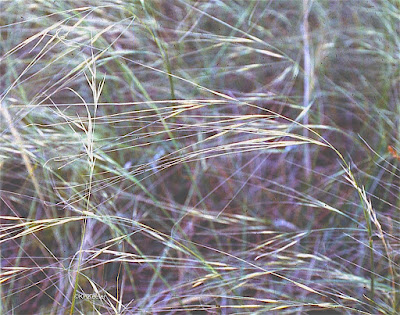Needle-and-thread grass (Hesperostipa comata, formerly is Stipa comata, grass family Poaceae) is native to the northwestern three quarters of North America, found especially on dry or sandy sites. It is a beautiful grass, with long slightly nodding heads that catch the sunlight and nod in the wind.

The nodding effect is due to the very long awns. (Awns are bristle-like appendages, often very distinctive characteristics of particular grasses. ) Needle-and-thread's awns can be 8" long and are usually 4-6". They make needle-and-thread dramatic and easily-recognized.
The seeds develop separately, not as several in a fruit, like, say, peas in a pod. For many grasses, often each seed is alone in a tiny fruit, "grain" we say. Needle-and-thread has a very long awn on each seed. The picture above shows a mature seed. The awn is coiled directly above the seed, so the awn was longer before the seed left the plant. In the photo at the top of this post and the just one below, the seeds are still on the plant and the awns are long and straight.

The name needle-and-thread comes from seeing the seed-and-awn as looking like a needle and thread.
The analogy is enhanced by the fact that the seed's tip is sharp. Very sharp.

The seed is heavier than the awn, so when released from the plant, the seed-and-awn tends to reach the ground seed-tip first. Even though it is predictable that the seed, with food for the seedling, would be relatively heavy, that's a neat bit of engineering, because the dispersing seeds need to be buried in the soil.
But needle-and-thread goes beyond that. As it dries out, the long awn slowly twists, driving the seed into the ground. It is really an impressive seed-planting mechanism. Here's a You-tube video showing the seed-and-awn slowly turning as the awn drives the seed into the ground: link. It is easy to see for yourself: find needle-and-thread and try it! Pull seed and awn off a plant, put them on the ground and watch.
The catch is: that same drilling reponse happens when the seed sticks into your socks. Most seeds in your socks are annoying because they scratch your skin. This one actively drives its seed into your ankle. Ok, not very far or very hard, but more than your average seed. A walk through northern prairies in late June and early July can fill your socks with needle-and-thread grass seeds. Ouch!
They make good toys. The seed-and-awn form nice little darts and probably have been tossed by children (of many ages) for millennia.
As forage for livestock and wildlife, needle-and-thread is nutritious. The seeds can be a problem for sheep and humans don't like being stuck by them, so needle-and-thread is not widely planted as a forage grass. Bigger animals, cows, horses, bison, do not seem bothered by the seeds and consume the grass all summer, so it is considered a good pasture grass and does not appear in weed books.
Nevertheless the seeds are very annoying to hikers and their dogs.
Historically the American bison wandered across most of the range of needle-and-thread. Bison have shaggy coats that are shed in the spring, perfect for dispersing seeds. Since free-ranging bison have been gone for more than 100 years, studies of seed dispersal rarely consider them. But needle-and-thread undoubtedly hitched rides on passing bison.

They flower in early June, seed by July (making them cool season grasses in the classification of mid-American grasses). Below, the yellow grass is needle-and-thread, going dormant in early July. They are perennials and growth will restart come cool temperatures in late September and October.
 |
| Needle-and-thread in July |
Comments and corrections welcome.
Kathy Keeler, A Wandering Botanist
More at awanderingbotanist.com
Join me on Facebook: https://www.facebook.com/AWanderingBotanist
More stories of plants native to northern Colorado and surrounding areas in my book
NoCo Notables: 15 Northern Colorado Plants Worth Knowing
Available on Amazon
link
More stories of plants native to northern Colorado and surrounding areas in my book
NoCo Notables: 15 Northern Colorado Plants Worth Knowing
Available on Amazon
link




No comments:
Post a Comment